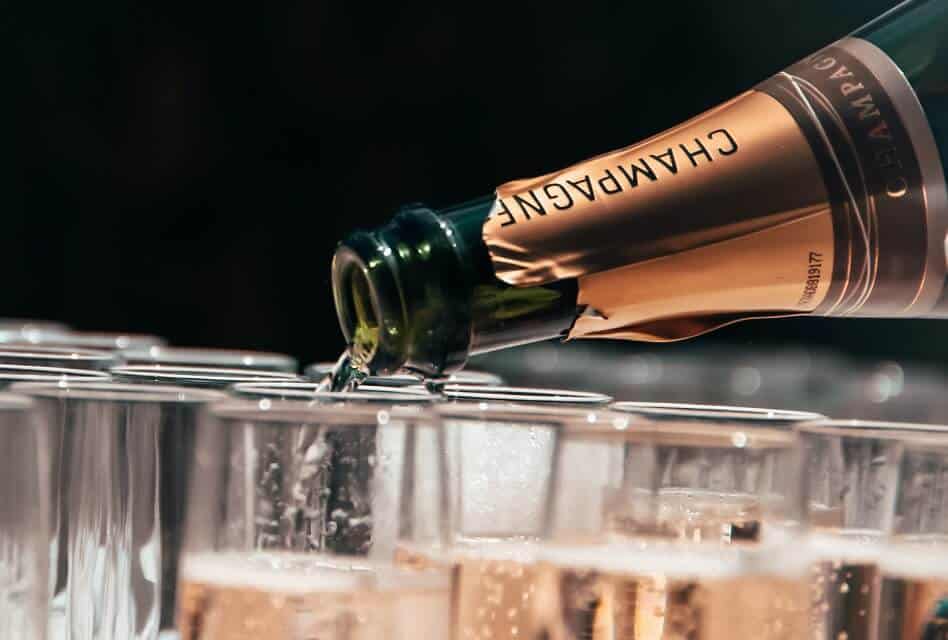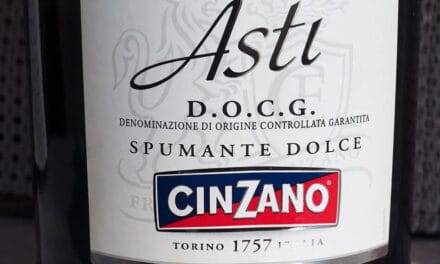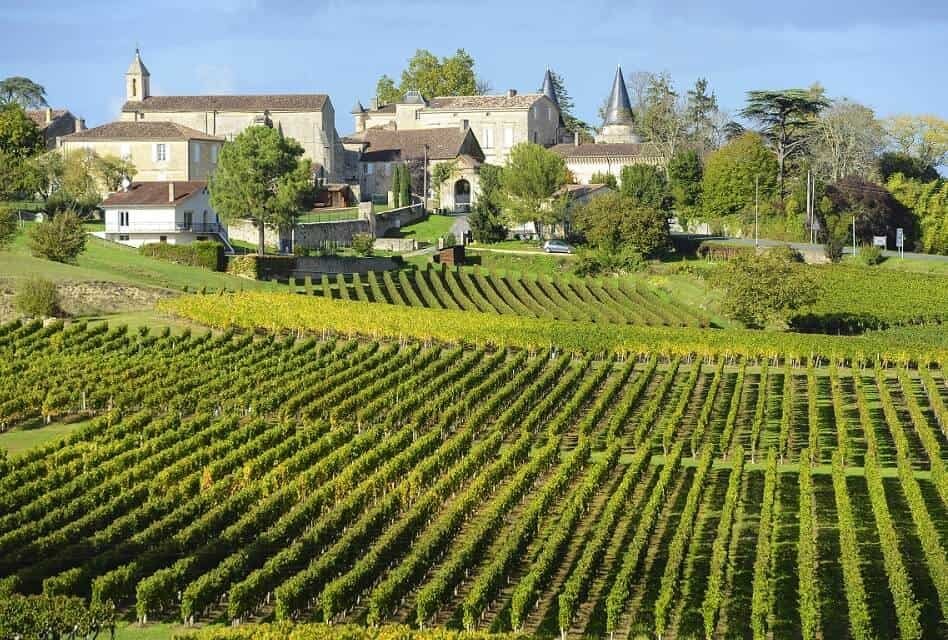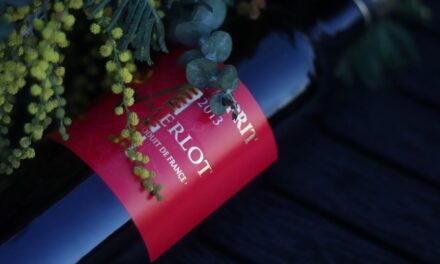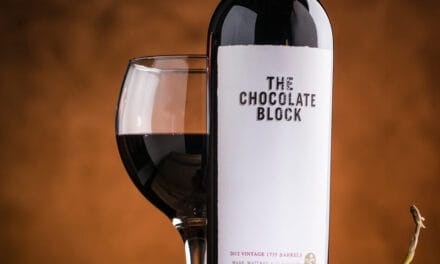There is no celebration without a fizzy glass of sparkling wine. And the first bubbly wine that comes to mind is Champagne. Undoubtedly, it is one of the world’s best sparkling wines. And, unfortunately, one of the most expensive. But what makes Champagne so special?
Champagne is a sparkling wine from the Champagne region in northeastern France. It is either white or rosé and ranges from semi-sweet to very dry. As it undergoes a complex, heavily regulated production process, it is of outstanding quality and typically high-priced.
In the following paragraphs, we will discuss the history, the different types, and the best ways to enjoy Champagne.
Are Champagne and Prosecco the Same?
No, Champagne and Prosecco are not the same. They both are sparkling whites and typically white, but their production processes differ significantly from each other. Besides, Champagne comes from the region with the same name in France, while Prosecco’s home is Italy.
Are Champagne and Sparkling Wine the Same?
No, Champagne and sparkling wine does not mean the same thing. Sparkling wine is a category of wines that are carbonated and thus have bubbles. Champagne is only one specific type in this category. But there are many others like Sekt, Cava, or Asti. So, Champagne is sparkling wine, but not every sparkling wine is Champagne.
WHERE DOES CHAMPAGNE COME FROM?
Champagne comes from the region with the same name. The Champagne region is located in the northeastern part of France and belongs to the political region Champagne-Ardenne.
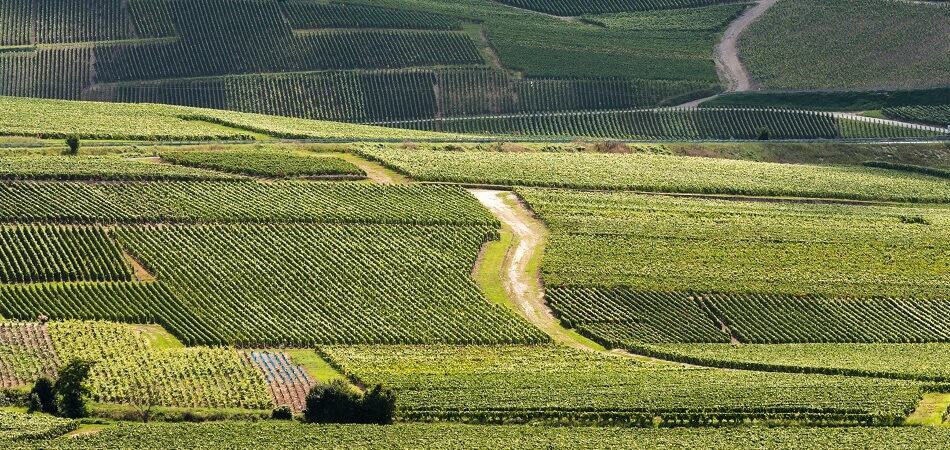
Vineyards in the Champagne Region
THE HISTORY OF CHAMPAGNE
The Champagne region has a long history of winemaking that goes back to the 5th century. Back then, the Romans cultivated grapes in this area and produced pale pinkish wines. In the following centuries, the local rulers made it a tradition to offer their wines to visiting monarchs.
But Champenois winemakers faced some severe challenges. Because of the region’s Northern climate, grapes often did not ripe completely and were overly acidic but low in sugar. The resulting wines were relatively thin and light-bodied. And although they gained some reputation across Western Europe, they were not a serious competition to the delicious red wines from Burgundy, Champagne’s southern neighbor.
Besides unripe grapes, the cold winters caused another problem for Champenois vintners: The cold temperatures regularly interrupted the fermentation processes because the yeast cells became inactive. When they woke up again in spring to continue their work, they created a lot of carbon dioxide as a byproduct. And with rising CO2 levels, the pressure inside the bottles increased, too. The extremely fragile bottles of the time often exploded as a result, and those that survived contained bubbles.
Bubbles in Wine – Flaw or Feature?
Up to the 17th century, these bubbles were considered a flaw. One of the most famous historical figures in winemaking, the Benedictine monk Dom Pérignon, actually tried to extract them from his bottles with different measures. Based on his experiments, he wrote down a set of winemaking rules that aimed to prevent the creation of bubbles but also contributed to healthier and more tasteful grapes. These rules included:
- Using only Pinot Noir grapes.
- Pruning vines to limit their growth and also the yields.
- Harvesting grapes manually in the early morning when it is damp and cool.
- Sorting out damaged grapes before crushing them.
- Pressing grapes not by stomping them but by using multiple mechanical presses.
- Separating grape solids from the juice, so the wine stays white instead of turning red.
- Avoiding additives.
Although his initial goal of keeping wine still lost its relevance later, many of his winemaking rules still are relevant for Champagne winemakers.
However, the rise of sparkling wines was not the result of Dom Perignon’s efforts. Instead, the British made them famous. They often bought barrels of French wine and bottled them for sale in England. As the climate on the British islands is comparable to the conditions in Champagne, they also faced the creation of bubbles in these wines. But the English glass was more stable than French glass, and in combination with the use of cork stoppers, their bottles could stand the pressure. And as the high society enjoyed the sparklers, they quickly became famous in Great Britain.
The new drink also aroused the interest of scientists who were eager to find out where the bubbles in wine came from. One of them, Christopher Merret, published a paper explaining the chemical process in 1662. He also detailed how to turn a still wine into a sparkling one by adding sugar. As a result, some wine experts claim that this paper proves that the British invented Champagne sparkling wine even before the French deliberately produced it.
The Rise of a Luxury Beverage Industry
From the 18th century on, sparkling wines gained popularity among French noblemen. To meet the increasing demand, Champenoise vintners started to make bubbly wines deliberately. But it took them until the middle of the 19th century to overcome technical problems and establish a profitable sparkling wine industry.
During this time, many of the big Champagne houses were established. Interestingly, some of the founders were Germans who came to the Champagne region to learn the art of making great sparkling wines. While many returned to Germany and started Sekt wineries, others stayed and founded now-famous companies like Mumm or Bollinger.
Today, Champagne is recognized as an “appellation d’origine contrôlée” (AOC) region, the highest French quality label. Champenoise vintners cultivate more than 35,000 hectares (around 86,500 acres) of vines and produce 200 million bottles of Champagne per year.
WHAT IS CHAMPAGNE MADE FROM?
Just like any other sparkling wine, Champagne is made from grapes. Due to the region’s laws, vintners can only use seven varietals, though:
- Pinot Noir is widespread in the Champagne region and is one of only two allowed red grapes. Winemakers use it to add body and elegance to their sparkling wines.
- Chardonnay is a commonly used white variety. Pure Chardonnay sparklers are light and acidic, while the grape adds structure when used in multiple-grape blends.
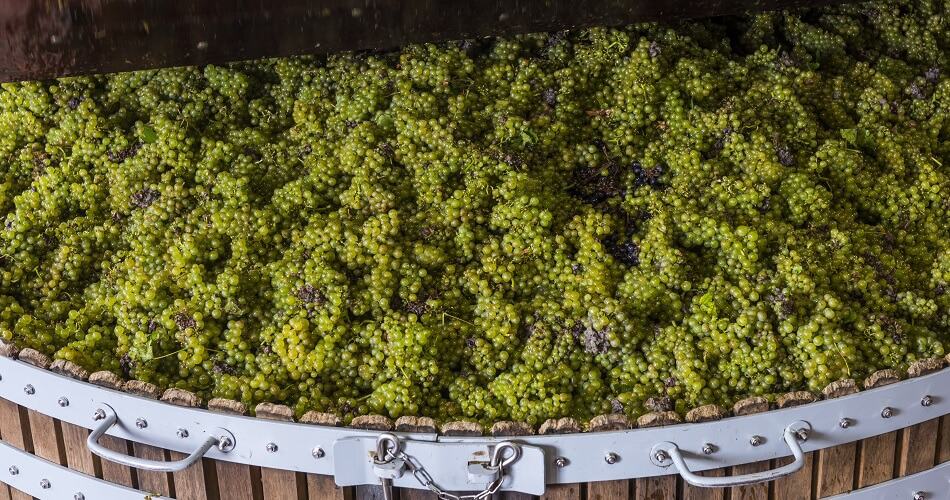
Chardonnay Grapes for Champagne Production
- Many vintners like Pinot Meunier grapes because they are less vulnerable to frost than Chardonnay or Pinot Noir. It is the second permitted red varietal, adding boldness and fruity flavors to blends. A good 100% Pinot Meunier Champagne might even taste like fruity red wine.
- Pinot Blanc vines produce big, white grapes that vintners process into zesty sparkling wines with aromas of flowers and honey. They are relatively rare in the region, though.
- Another rare white variety for Champagne production is Pinot Gris, also known as Fromenteau. It is famous for its aromas of citrus and green fruits.
- White Petit Meslier grapes are similarly robust as Pinot Meunier. Many wine lovers compare it to Sauvignon Blanc because of the vegetal notes it adds to a blend.
- Arbane is probably the rarest of all Champagne grapes. One reason might be that it is high in maintenance and produces very low yields. It is a late-ripening white varietal and produces sparkling wines with notes of green fruits and herbs.
THE DIFFERENT TYPES OF CHAMPAGNE
Although Champagne sparkling wines are subject to strict regulation, vintners have sufficient freedom to create several different types. They vary in color, sweetness, and aromas, and you can recognize the different types by their names.
Champagne Types by Sweetness
Sweetness is an essential factor in the taste of Champagne. Vintners produce styles that range from very dry to semi-sweet, and they typically state the sweetness on their bottles’ labels. The following terms indicate the sweetness of Champagne:
- Extra-Brut Champagne is the driest type. It has less than 6 grams of residual sugar per liter of wine.
- Most types are Brut. They have between 6 and 12 grams of sugar per liter.
- Extra Dry Champagne ranges from 12 to 17 g/L. Unlike the former types, it has a minimal sweet note to it.
- Sec styles are a bit sweeter with 17 to 32 g/L.
- Demi-Sec Champagne is perceivably sweet and has between 32 and 50 g/L.
- The sweetest styles are called Doux. They have more than 50 grams of sugar per liter.
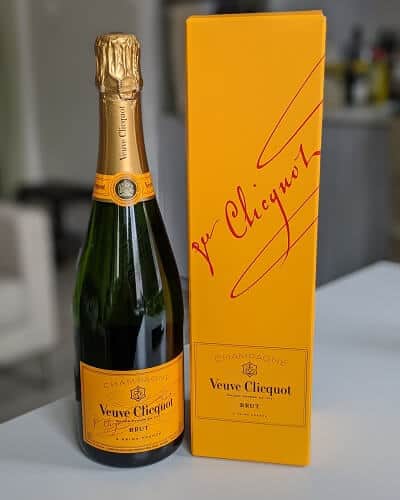
Bottle of Brut Champagne
Champagne Types by Color
As mentioned before, Champagne comes in different colors, and for these colors, vintners have established various nominations. These nominations indicate not only a sparkling wine’s color but also the grapes it was made from.
Blanc de Blancs
Blanc de Blancs (English: White of Whites) Champagne is white and made only from white grapes. Since 1980, Chardonnay has been the only variety that vintners may use to make these white styles. This varietal produces acidic wines that commonly have citrus notes.
Blanc de Noirs
In contrast, Blanc de Noirs (English: White of Blacks) wines are made from red varieties only. Nevertheless, the final wine is white. Pure Pinot Noir types are common, but some vintners also use Pinot Meunier. Blanc de Noirs Champagne often provides delicious aromas of red and black fruit.
White Blends
Many Champagnes are blends from both white and red grapes. Although Pinot Noir, Pinot Meunier, and Chardonnay are the most common ingredients, vintners also use the other permitted grapes for these blends. Consequently, they can differ massively in taste.
Rosé Champagne
Before Champagne vintners figured out how to make white sparkling wine, they produced still wines that typically were pink. Today, they use both red and white grapes to make rosé sparkling wine. The color comes from a short period of maceration: The pressed grape juice is allowed to stay in contact with the solids (such as stems, skins, and seeds), so it can absorb a bit of color. Typically, rosé Champagne tends to be on the sweeter side of the spectrum.
Red Champagne
If you are a lover of sparkling red wines, here is some bad news: There is no red Champagne. The reason is historical. Back in the 17th and 18th centuries, when Champagne’s rise to fame started, color was not a quality indicator. Instead, winemakers tried to produce sparkling wines that were brilliant and elegant. And even when using red grapes, the best way to determine brilliance was by making a white base wine first. So if you are into red sparklers, you must rely on other types, such as Lambrusco or Brachetto.
Champagne Quality Labels
In addition to the color and sweetness, you might occasionally find other terms on bottle labels that indicate a specific quality level or production process.
Premier Cru
Premier Cru is a quality label awarded to single communes within the Champagne appellation, which are famous for their terroir and the wines they produce. All communes are rated on a scale of 1 to 100 (although there is none with a rating lower than 80). And those with a rating between 90 to 99 receive the Premier Cru status. Currently, that’s true for 42 of the more than 350 communes. It indicates that the vineyards in these areas produce grapes of extraordinary quality. This quality label heavily impacts the prices of grapes and the final sparkling wines.
Grand Cru
Grand Cru communes are rated at a perfect 100, so they are the top of the top in Champagne. Only 17 communes belong to this category, making up about 9% of all Champagne vineyards.
Cuvée
Cuvée describes a Champagne made from the first gentle pressing of a batch of grapes. Typically, it is the first 2050 liters of juice extracted from a batch of 4000 kilograms of grapes. This juice is of higher quality than the rest.
Vintage Champagne
Most Champagne is Non-Vintage Champagne. That means it is a blend of wines from different communes and years that vintners carefully combine to find the optimal taste.
In some rare cases, grapes enjoy optimal weather conditions and are so extraordinarily good by the time of harvest that the resulting base wine is perfect. In these cases, winemakers waive the blending. Instead, they produce Vintage Champagne. These fantastic sparklers are easy to recognize because their labels state the year of harvest.
HOW CHAMPAGNE IS MADE
>Making Champagne is a sophisticated process characterized by century-old traditions, strict production laws, and careful manual labor. It consists of multiple steps, and it is not unusual for the process takes years to produce a great bottle of Champagne. In the following paragraphs, we will discuss the steps to do so.
Harvest
The Champagne grapes harvest occurs between August and October, depending on how ripe the grapes are. Vintners regularly take samples and check their sugar levels to find the optimal harvesting date. It happens earlier in years with good weather and a lot of sunshine, while vintners have to wait longer in colder years. According to the region’s wine laws, workers must hand-pick the grapes to minimize the risk of damaging them; using machines is not allowed.
Pressing
After picking them, the grapes are transported to a pressing center, where workers document the origin, harvesting date, and weight of each load.
The pressing takes part in numerous iterations. Especially the first, very gentle pressing is vital because it produces the most precious juice: the cuvée. From this cuvée, vintners produce some of the best (and most expensive) sparkling wines. Cuvée Champagne can cost up to five times more than regular Champagne. One reason for this high price is that it is strictly limited: From 4,000 kilograms of grapes, winemakers can extract only 2050 liters of cuvée.
After that, vintners may press their grapes for a second and a third time. But they face limitations in quantity again: From each of these follow-up pressings, they can gain only 333 liters of additional juice. This juice is typically less acidic but offers richer fruit flavors. Vinters don’t process it into cuvée wines, though. Instead, they use it to make affordable entry-level sparkling wines.
First Fermentation
The next step is the production of still base wine, and it is very similar to the production of regular table wines. The vintners transfer the juice into tanks and add yeast to start the fermentation. Some use wooden barrels instead of steel tanks. But as this is much more difficult, it is rather the exception than the rule.
During the fermentation, the yeasts slowly transform the grape sugar into alcohol. The result at the end of the process is a highly acidic base wine.
Assemblage
Following the fermentation, Champagne vintners blend the wine. They mix wines from different communes and years to create an optimal base wine representing their winery’s style best. To find the perfect recipe, they might combine dozens, sometimes even hundreds, of single wines. This process is called Assemblage (English: Assembly), and the resulting sparkling wines are called Non-Vintage Champagnes (short: NV). About 80% of all Champagne sparkling wines belong to this category.
Logically, this step is not necessary for Vintage Champagnes.
The Second Fermentation
When the blending is done, the base wines undergo a second fermentation. That’s where they’re transformed into sparkling wines. Before starting fermentation again, the vintners bottle the wines. Then, they add “liqueur de tirage”, a mix of wine, sugar, and yeast, to the bottles and seal them. The yeast consumes the sugar and transforms it into alcohol and carbon dioxide. As the bottles are sealed, the carbon dioxide cannot escape and stays as bubbles in the wine.
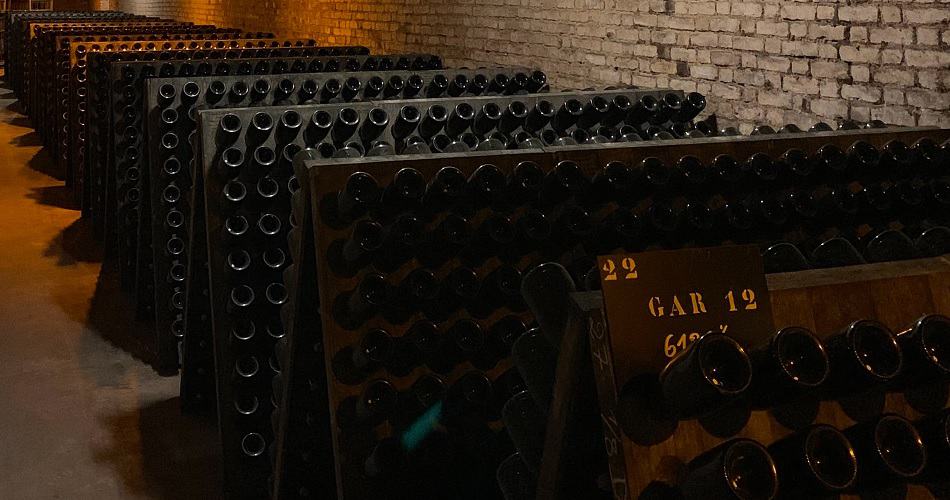
Champagne Fermenting in Bottles
This way of bottle fermentation is also called “Méthode Champenoise” (English: Champagne Method) because Champenoise vintners developed it. And today, wine laws mandate them to follow this method. Outside Champagne, sparkling wine producers also use this technique but typically refer to it as “Traditional Method”.
Aging
Usually, after a couple of months, the yeast cells die, and the fermentation comes to an end. Nevertheless, the vintner lets the Champagne sit on the lees (the dead yeasts) to mature and improve its aromas.
By law, Non-Vintage Champagnes must age in the bottle for at least one year, and Vintage styles three years or more. Champenoise vintners tend to exceed these requirements, though. Especially when making very expensive sparkling wines, they allow them to mature for up to five years.
Riddling and Disgorging
The next step in Champagne production is extracting the dead yeast cells. The vintner places the bottle upside down in a special “riddled” rack to reach this goal. The riddler turns the bottle daily, so the yeasts move into the bottleneck.
Finally, the winemakers freeze the bottleneck, so a plug of frozen wine and dead yeast cells is formed. Then, they remove the cork, and the pressure of the CO2 forces the plug out of the bottle.
Dosage
During the disgorging, a little wine gets lost. To compensate for this loss, vintners fill the bottle with a mixture of wine, grape spirit, and sugar. This “liqueur d’expédition” also determines the final level of sweetness that the Champagne will have. After the dosage, the bottle is recorked and is ready for sale.
HOW TO SERVE CHAMPAGNE
Typically, Champagne is served to celebrate special occasions like weddings, anniversaries, or successful business deals. Most of the time, it comes on its own or with finger food. Having it with dinner is uncommon, but you can create delicious champagne and food pairings, as we will discuss later.
What is the Right Glass for Champagne?
The optimal glass for Champagne is a flute. This tall, slim glass prevents the bubbles from escaping too quickly, so it keeps sparkling wine fresh longer. It also contributes to the optimal temperature: The long stem creates a significant distance between the drinker’s warm hand and the wine, so it doesn’t heat up too fast.
Sometimes Champagne comes in a Coupe glass that is the opposite of a flute. It is much smaller, with a short stem and a wide bowl. It is fair to say that these vintage-style glasses look fancier than most flutes, and they are great for building spectacular-looking pyramids. However, due to their shape, the Champagne heats up and loses its fizz much faster when served in Coupe glasses. So these glasses are fine for a show effect, but if you want to treat your Champagne properly, better pick a flute.

Riedel Vinum Champagne Flutes (Set of 2)
$64.97
from: Wine.com
What is the Right Serving Temperature for Champagne?
When serving Champagne to your guests, make sure it is chilled. The precise serving temperature depends on the style: Vintage Champagne is excellent at 46 to 50 degrees Fahrenheit (8-10°C). Non-vintage Champagne should be even cooler: Aim for 43 to 46° max (6-8°C).
Should You Decant Champagne?
Most wine lovers would answer this question with “no”. And that is a reasonable answer because as soon as you open a bottle of sparkling wine, it starts losing its bubbles. Also, it heats up and quickly surpasses its optimal serving temperature. So, for most Champagnes, you should waive decanting and serve them right away.
However, there are some exceptions. Old vintage Champagne is typically a very complex beverage, and it does need some time to release all of its delicate flavors. Thus, decanting does help them. Make sure to limit it to not more than 30 minutes, though.
HOW TO STORE CHAMPAGNE
Champagne is vulnerable to high temperatures and temperature changes. Thus, you should keep it in a dark and cool place, preferably in your basement. Ensure to keep it away from vibrating devices such as washing machines or air conditioning. Also, do not store it in the same room with chemicals like cleaning agents, wall paint, or heating oil. The aggressive smells from these substances can invade a bottle via the cork and ruin them.
Can Champagne Be Aged?
Yes, some types can be aged. In particular, Vintage Champagne tends to get better if you store them in your cellar for a few years. Some vintners even deliberately produce these vintage styles for aging, so when drinking them immediately after buying, you might miss some of their potential.
An interesting detail that you might want to consider is the bottle size. While standard-sized bottles are considered suitable for aging, many experts agree that magnum bottles are even better. The reason is that there is more contact between the yeast and the wine, which leads to more carbonation. And with more CO2, a sparkling wine keeps longer without getting flat.
Non-vintage sparkling wines typically have little to no aging potential. Thus, it doesn’t make much sense to keep them for years. Better enjoy them soon after buying them.
Can Champagne Go Bad?
Yes, Champagne can go bad. Just like any other still or sparkling wine, it is prone to oxidation. When the air gets in touch with it, it starts chemical processes that cause the wine to spoil. It loses its aromas and, after some time, gets a very unpleasant vinegar-like taste.
A flaw that occurs even faster is the loss of bubbles. Just a couple of hours after opening the bottle, the carbon dioxide will be gone and leave your Champagne flat and dull.
How Long Does Champagne Last When Open?
Like most sparkling wines, Champagne has a very short life span after opening it. As said before, It will rapidly lose its bubble, and without the bubbles, it becomes flat and dull. Thus, you should consume it quickly. If you do not finish it the same day, reseal it properly with the original cork or a plastic stopper. Make sure to store it in the fridge and consume it within 2 to 3 days.
CHAMPAGNE AND FOOD PAIRINGS
As mentioned before, you can create delicious food and Champagne pairings. It might sound odd to have sparkling wine with dinner, but you might be surprised how well it actually works.
Blanc de Blanc Champagne and Food
Blanc de Blanc Champagnes are dry, acidic, and full of citrus aromas, making them excellent matches for all kinds of foods. Especially light kinds of seafood are good pairings. Think of oysters, caviar, or snapper. Blanc de Blanc wines also can work with lobster, but you should pick a Vintage style. Vintage wines are typically a bit richer than Non-Vintage wines and, therefore, better matches for rich lobster dishes. Fried foods such as Fish ‘n Chips or calamari work surprisingly well, too.
You can also pair these great wines with creamy cheese. In particular, those from France are delicious pairings. Try Brie or Camembert.
Blanc de Noir Champagne and Food
Blanc de Noir sparklers are a bit heavier than Blanc de Blanc wines. They offer aromas of red and black fruit that work very well with bolder fish dishes. Try the formerly mentioned lobster or mackerel.
When searching for a cheese to pair with Blanc de Noir Champagne, look out for aged hard cheeses, for example, Beaufort, Gouda, or Parmesan. For these salty and nutty cheeses, the fruity notes of Blanc de Noir wines are fantastic complements.
Rosé Champagne and Food
Rosé Champagnes offer an outstanding combination of fresh acidity, complex berry flavors, and fizzy bubbles. In many cases, you might sense a subtle sweetness as well. This combination makes rosé Champagne a very versatile wine.
It’s great with many spicy meals like chicken or duck dishes from Asian cuisine. In particular, vintage rosé also works with lamb roasts, and flavorful cured meats, no matter if you eat them on their own as an aperitif or as a pizza topping.
Hearty seafood is another option. Roasted or grilled preparations of lobster, swordfish, or salmon are delicious with Rosés.
Finally, you can choose a pink sparkler to go with dessert. Make sure the dish is not too sweet, though. Fruit salads, cakes, and many creamy meals are fine, but chocolate dishes might be too heavy.
Demi-Sec Champagne and Food
Demi-Sec sparkling wines offer a perceivable sweetness. This characteristic makes them a proper pairing for desserts. Fruit-based dishes are delicate, and so are creamy preparations like Crème Brulée or Mousse au Chocolate.
Demi-Sec Champagne is also delicious with blue cheeses like Roquefort, Stilton, or Gorgonzola. Its sweetness is a fantastic counterplayer for these pungent cheeses, while its bubbles help clean the palate after each bite.
CHAMPAGNE SHOPPING TIPS
Champagne is a protected name for sparkling wines from the region with the same name. At least, that is true in Europe. Outside of Europe, you might come across wines that carry this label, although they do not come from France and do not fulfill the strict production rules of the original sparkler. Thus, you should always double-check the origin of a bottle before you buy it. Most bottles carry the term Champagne and the winery’s name. It is also common to print the founding year of the winery on the label.
Another indicator of an original Champagne sparkling wine is its price. The traditional production methods are costly, and these costs are reflected in the price tag. It is very unusual to find a decent Champagne for less than 40 USD per 750ml bottle. And for high-quality styles, you should be willing to invest at least 100 USD.
Entry Level Champagne
- type: white, sparkling
- origin: Champagne, France
- varietal: Chardonnay, Pinot Noir
- alcohol: 12.0%
- type: white, sparkling
- origin: Champagne, France
- varietal: Chardonnay, Pinot Noir, Pinot Meunier
- alcohol: 12.0%
- type: white, sparkling
- origin: Champagne, France
- varietal: Chardonnay, Pinot Noir, Pinot Meunier
- alcohol: 12.5%
High-Quality Champagne
Laurent-Perrier Grand Siecle No. 24
- type: white, sparkling
- origin: Champagne, France
- varietal: Chardonnay, Pinot Noir
- alcohol: 12.0%
- type: white, sparkling, Vintage
- origin: Champagne, France
- varietal: Chardonnay, Pinot Noir
- alcohol: 12.5%
Armand de Brignac Ace of Spades Brut Gold
- type: white, sparkling
- origin: Champagne, France
- varietal: Chardonnay, Pinot Noir, Pinot Meunier
- alcohol: 12.5%
Rosé Champagne
- type: rosé, sparkling
- origin: Champagne, France
- varietal: Chardonnay, Pinot Noir
- alcohol: 12.5%
Champagne Mouzon-Leroux L'Incandescent Rosé de Saignée Extra Brut
- type: rosé, sparkling
- origin: Champagne, France
- varietal: Pinot Noir
- alcohol: 12.0%
- type: rosé, sparkling
- origin: Champagne, France
- varietal: Chardonnay, Pinot Noir, Pinot Meunier
- alcohol: 12.0%
FINAL WORDS
Without a doubt, Champagne is one of the world’s most prestigious wines. After reading this article, you will know why. And you also know that it’s not only a drink for festivities but also an excellent add-on for your next dinner party. So make sure you have a bottle ready to pop open.

